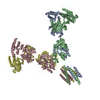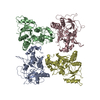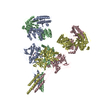+ Open data
Open data
- Basic information
Basic information
| Entry | Database: PDB / ID: 8usw | |||||||||||||||
|---|---|---|---|---|---|---|---|---|---|---|---|---|---|---|---|---|
| Title | CNQX-bound GluN1a-3A NMDA receptor | |||||||||||||||
 Components Components |
| |||||||||||||||
 Keywords Keywords |  MEMBRANE PROTEIN / Channel / MEMBRANE PROTEIN / Channel /  receptor receptor | |||||||||||||||
| Function / homology |  Function and homology information Function and homology informationnegative regulation of dendritic spine development / pons maturation /  regulation of cell communication / positive regulation of Schwann cell migration / EPHB-mediated forward signaling / Assembly and cell surface presentation of NMDA receptors / olfactory learning / regulation of cell communication / positive regulation of Schwann cell migration / EPHB-mediated forward signaling / Assembly and cell surface presentation of NMDA receptors / olfactory learning /  conditioned taste aversion / protein localization to postsynaptic membrane / conditioned taste aversion / protein localization to postsynaptic membrane /  dendritic branch ...negative regulation of dendritic spine development / pons maturation / dendritic branch ...negative regulation of dendritic spine development / pons maturation /  regulation of cell communication / positive regulation of Schwann cell migration / EPHB-mediated forward signaling / Assembly and cell surface presentation of NMDA receptors / olfactory learning / regulation of cell communication / positive regulation of Schwann cell migration / EPHB-mediated forward signaling / Assembly and cell surface presentation of NMDA receptors / olfactory learning /  conditioned taste aversion / protein localization to postsynaptic membrane / conditioned taste aversion / protein localization to postsynaptic membrane /  dendritic branch / regulation of respiratory gaseous exchange / propylene metabolic process / response to glycine / voltage-gated monoatomic cation channel activity / response to morphine / glutamate-gated calcium ion channel activity / Assembly and cell surface presentation of NMDA receptors / regulation of monoatomic cation transmembrane transport / dendritic branch / regulation of respiratory gaseous exchange / propylene metabolic process / response to glycine / voltage-gated monoatomic cation channel activity / response to morphine / glutamate-gated calcium ion channel activity / Assembly and cell surface presentation of NMDA receptors / regulation of monoatomic cation transmembrane transport /  glutamate receptor activity / glutamate receptor activity /  NMDA glutamate receptor activity / NMDA selective glutamate receptor complex / RAF/MAP kinase cascade / Synaptic adhesion-like molecules / parallel fiber to Purkinje cell synapse / calcium ion transmembrane import into cytosol / protein heterotetramerization / NMDA glutamate receptor activity / NMDA selective glutamate receptor complex / RAF/MAP kinase cascade / Synaptic adhesion-like molecules / parallel fiber to Purkinje cell synapse / calcium ion transmembrane import into cytosol / protein heterotetramerization /  glutamate binding / positive regulation of reactive oxygen species biosynthetic process / neuromuscular process / glutamate binding / positive regulation of reactive oxygen species biosynthetic process / neuromuscular process /  regulation of synapse assembly / regulation of synapse assembly /  glycine binding / positive regulation of calcium ion transport into cytosol / male mating behavior / regulation of neuronal synaptic plasticity / regulation of dendrite morphogenesis / glycine binding / positive regulation of calcium ion transport into cytosol / male mating behavior / regulation of neuronal synaptic plasticity / regulation of dendrite morphogenesis /  regulation of axonogenesis / suckling behavior / dendrite development / regulation of axonogenesis / suckling behavior / dendrite development /  startle response / response to amine / monoatomic cation transmembrane transport / startle response / response to amine / monoatomic cation transmembrane transport /  social behavior / positive regulation of excitatory postsynaptic potential / ligand-gated monoatomic ion channel activity / social behavior / positive regulation of excitatory postsynaptic potential / ligand-gated monoatomic ion channel activity /  associative learning / monoatomic cation transport / associative learning / monoatomic cation transport /  excitatory synapse / positive regulation of dendritic spine maintenance / Unblocking of NMDA receptors, glutamate binding and activation / excitatory synapse / positive regulation of dendritic spine maintenance / Unblocking of NMDA receptors, glutamate binding and activation /  long-term memory / long-term memory /  glutamate receptor binding / glutamate receptor binding /  phosphatase binding / calcium ion homeostasis / phosphatase binding / calcium ion homeostasis /  synaptic cleft / cellular response to manganese ion / synaptic cleft / cellular response to manganese ion /  prepulse inhibition / regulation of neuron apoptotic process / glutamate-gated receptor activity / presynaptic active zone membrane / response to fungicide / monoatomic cation channel activity / sensory perception of pain / dendrite membrane / ligand-gated monoatomic ion channel activity involved in regulation of presynaptic membrane potential / response to amphetamine / prepulse inhibition / regulation of neuron apoptotic process / glutamate-gated receptor activity / presynaptic active zone membrane / response to fungicide / monoatomic cation channel activity / sensory perception of pain / dendrite membrane / ligand-gated monoatomic ion channel activity involved in regulation of presynaptic membrane potential / response to amphetamine /  excitatory postsynaptic potential / hippocampal mossy fiber to CA3 synapse / presynaptic modulation of chemical synaptic transmission / ionotropic glutamate receptor signaling pathway / excitatory postsynaptic potential / hippocampal mossy fiber to CA3 synapse / presynaptic modulation of chemical synaptic transmission / ionotropic glutamate receptor signaling pathway /  regulation of membrane potential / positive regulation of synaptic transmission, glutamatergic / adult locomotory behavior / transmitter-gated monoatomic ion channel activity involved in regulation of postsynaptic membrane potential / protein phosphatase 2A binding / regulation of membrane potential / positive regulation of synaptic transmission, glutamatergic / adult locomotory behavior / transmitter-gated monoatomic ion channel activity involved in regulation of postsynaptic membrane potential / protein phosphatase 2A binding /  synaptic membrane / synaptic membrane /  learning / learning /  synaptic transmission, glutamatergic / postsynaptic density membrane / regulation of long-term neuronal synaptic plasticity / synaptic transmission, glutamatergic / postsynaptic density membrane / regulation of long-term neuronal synaptic plasticity /  regulation of synaptic plasticity / modulation of chemical synaptic transmission / regulation of synaptic plasticity / modulation of chemical synaptic transmission /  calcium channel activity / calcium channel activity /  visual learning / visual learning /  terminal bouton / intracellular calcium ion homeostasis / synaptic vesicle membrane / response to organic cyclic compound / cerebral cortex development / terminal bouton / intracellular calcium ion homeostasis / synaptic vesicle membrane / response to organic cyclic compound / cerebral cortex development /  memory / neuron cellular homeostasis / response to calcium ion / rhythmic process / calcium ion transport / memory / neuron cellular homeostasis / response to calcium ion / rhythmic process / calcium ion transport /  synaptic vesicle / presynapse / synaptic vesicle / presynapse /  signaling receptor activity / signaling receptor activity /  presynaptic membrane / presynaptic membrane /  amyloid-beta binding / chemical synaptic transmission / amyloid-beta binding / chemical synaptic transmission /  postsynaptic membrane postsynaptic membraneSimilarity search - Function | |||||||||||||||
| Biological species |   Homo sapiens (human) Homo sapiens (human) | |||||||||||||||
| Method |  ELECTRON MICROSCOPY / ELECTRON MICROSCOPY /  single particle reconstruction / single particle reconstruction /  cryo EM / Resolution: 4.23 Å cryo EM / Resolution: 4.23 Å | |||||||||||||||
 Authors Authors | Michalski, K. / Furukawa, H. | |||||||||||||||
| Funding support |  United States, 4items United States, 4items
| |||||||||||||||
 Citation Citation |  Journal: Sci Adv / Year: 2024 Journal: Sci Adv / Year: 2024Title: Structure and function of GluN1-3A NMDA receptor excitatory glycine receptor channel. Authors: Kevin Michalski / Hiro Furukawa /  Abstract: -methyl-d-aspartate receptors (NMDARs) and other ionotropic glutamate receptors (iGluRs) mediate most of the excitatory signaling in the mammalian brains in response to the neurotransmitter glutamate. ...-methyl-d-aspartate receptors (NMDARs) and other ionotropic glutamate receptors (iGluRs) mediate most of the excitatory signaling in the mammalian brains in response to the neurotransmitter glutamate. Uniquely, NMDARs composed of GluN1 and GluN3 are activated exclusively by glycine, the neurotransmitter conventionally mediating inhibitory signaling when it binds to pentameric glycine receptors. The GluN1-3 NMDARs are vital for regulating neuronal excitability, circuit function, and specific behaviors, yet our understanding of their functional mechanism at the molecular level has remained limited. Here, we present cryo-electron microscopy structures of GluN1-3A NMDARs bound to an antagonist, CNQX, and an agonist, glycine. The structures show a 1-3-1-3 subunit heterotetrameric arrangement and an unprecedented pattern of GluN3A subunit orientation shift between the glycine-bound and CNQX-bound structures. Site-directed disruption of the unique subunit interface in the glycine-bound structure mitigated desensitization. Our study provides a foundation for understanding the distinct structural dynamics of GluN3 that are linked to the unique function of GluN1-3 NMDARs. | |||||||||||||||
| History |
|
- Structure visualization
Structure visualization
| Structure viewer | Molecule:  Molmil Molmil Jmol/JSmol Jmol/JSmol |
|---|
- Downloads & links
Downloads & links
- Download
Download
| PDBx/mmCIF format |  8usw.cif.gz 8usw.cif.gz | 464.1 KB | Display |  PDBx/mmCIF format PDBx/mmCIF format |
|---|---|---|---|---|
| PDB format |  pdb8usw.ent.gz pdb8usw.ent.gz | 342.5 KB | Display |  PDB format PDB format |
| PDBx/mmJSON format |  8usw.json.gz 8usw.json.gz | Tree view |  PDBx/mmJSON format PDBx/mmJSON format | |
| Others |  Other downloads Other downloads |
-Validation report
| Arichive directory |  https://data.pdbj.org/pub/pdb/validation_reports/us/8usw https://data.pdbj.org/pub/pdb/validation_reports/us/8usw ftp://data.pdbj.org/pub/pdb/validation_reports/us/8usw ftp://data.pdbj.org/pub/pdb/validation_reports/us/8usw | HTTPS FTP |
|---|
-Related structure data
| Related structure data |  42520MC  8usxC  8uueC M: map data used to model this data C: citing same article ( |
|---|---|
| Similar structure data | Similarity search - Function & homology  F&H Search F&H Search |
- Links
Links
- Assembly
Assembly
| Deposited unit | 
|
|---|---|
| 1 |
|
- Components
Components
| #1: Protein | Mass: 95041.672 Da / Num. of mol.: 2 Source method: isolated from a genetically manipulated source Source: (gene. exp.)   Homo sapiens (human) / Gene: Grin1 / Production host: Homo sapiens (human) / Gene: Grin1 / Production host:   Spodoptera frugiperda (fall armyworm) / References: UniProt: P35439 Spodoptera frugiperda (fall armyworm) / References: UniProt: P35439#2: Protein | Mass: 104837.195 Da / Num. of mol.: 2 Source method: isolated from a genetically manipulated source Source: (gene. exp.)   Homo sapiens (human) / Gene: GRIN3A / Production host: Homo sapiens (human) / Gene: GRIN3A / Production host:   Spodoptera frugiperda (fall armyworm) / References: UniProt: Q8TCU5 Spodoptera frugiperda (fall armyworm) / References: UniProt: Q8TCU5#3: Chemical | Mass: 232.152 Da / Num. of mol.: 2 / Source method: obtained synthetically / Formula: C9H4N4O4 / Feature type: SUBJECT OF INVESTIGATION Has ligand of interest | Y | |
|---|
-Experimental details
-Experiment
| Experiment | Method:  ELECTRON MICROSCOPY ELECTRON MICROSCOPY |
|---|---|
| EM experiment | Aggregation state: PARTICLE / 3D reconstruction method:  single particle reconstruction single particle reconstruction |
- Sample preparation
Sample preparation
| Component | Name: CNQX-bound GluN1-3A NMDA receptor / Type: COMPLEX / Entity ID: #1-#2 / Source: RECOMBINANT |
|---|---|
| Molecular weight | Value: 0.4 MDa / Experimental value: NO |
| Source (natural) | Organism:   Homo sapiens (human) Homo sapiens (human) |
| Source (recombinant) | Organism:   Spodoptera frugiperda (fall armyworm) Spodoptera frugiperda (fall armyworm) |
| Buffer solution | pH: 7.5 |
| Specimen | Embedding applied: NO / Shadowing applied: NO / Staining applied : NO / Vitrification applied : NO / Vitrification applied : YES : YES |
Vitrification | Cryogen name: ETHANE |
- Electron microscopy imaging
Electron microscopy imaging
| Experimental equipment |  Model: Titan Krios / Image courtesy: FEI Company |
|---|---|
| Microscopy | Model: FEI TITAN KRIOS |
| Electron gun | Electron source : :  FIELD EMISSION GUN / Accelerating voltage: 300 kV / Illumination mode: OTHER FIELD EMISSION GUN / Accelerating voltage: 300 kV / Illumination mode: OTHER |
| Electron lens | Mode: OTHER / Nominal defocus max: 2200 nm / Nominal defocus min: 800 nm / Cs : 2.7 mm : 2.7 mm |
| Image recording | Electron dose: 60 e/Å2 / Film or detector model: GATAN K3 (6k x 4k) |
- Processing
Processing
| EM software | Name: cryoSPARC / Category: 3D reconstruction |
|---|---|
CTF correction | Type: NONE |
3D reconstruction | Resolution: 4.23 Å / Resolution method: FSC 0.143 CUT-OFF / Num. of particles: 264487 / Symmetry type: POINT |
 Movie
Movie Controller
Controller





 PDBj
PDBj



